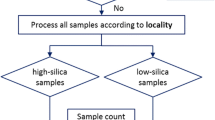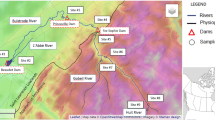Abstract
Three discriminant function models are raised and cross-compared in order to distinguish geochemical patterns characteristic for the Drava River floodplain sediments. Based on data representing total element concentrations in samples collected from alluvium (A), terrace (T), and unconsolidated bedrock (B) at the border of a floodplain, four element clusters emerged accounting for discrimination between the referred groups of sediments. The most prominent is contaminant/carbonate cluster characteristic for alluvium. The other two are: silicate cluster typical for unconsolidated geological substrate (Neogene sedimentary rocks); and naturally dispersed heavy metal cluster separating terrace from the former two groups. Models introducing depth intervals and single profiles as grouping criteria reveal identical sediment-heavy metal matrices. The second important issue of this paper is possibility of reclassification of samples originally assigned to one of the a priori defined groups of sediments, based on established geochemical pattern. The mapped geological units can be reconsidered by the post hoc assignments to a different group if geological border between alluvium and terrace or between terrace and bedrock can not be established geologically with absolute certainty.





Similar content being viewed by others
References
Abd El-Azim H, El-Moselhy KhM (2005) Determination and partitioning of metals in sediments along the Suez Canal by sequential extraction. J Mar Syst 56(3–4):363–374
Amorosi A, Summartino I (2007) Influence of sediment provenance on background values of potentially toxic metals from near-surface sediments of Po coastal plain (Italy). Int J Earth Sci 96:389–396
Andjelov M (1993) Results of radiometric and geochemical measurements for the natural radioactivity map of Slovenia. Geologija 36:223–248 (In Slovenian; English abstract)
Bidovec M, Šajn R, Gosar M (1998) The use of recent overbank sediments in geochemical mapping of Slovenia (in Slovenian; English abstract). Geologija 41:275–317
Bølviken B, Bogen J, Jartun M, Langedal M, Ottesen RT, Volden T (2004) Overbank sediments: a natural bed blending sampling medium for large-scale geochemical mapping. Chemometr Intell Lab Syst 74:183–199
Bottrill LJ, Walling DE, Leeks GJ (1999) Geochemical characteristics of overbank deposits and their potential for determining suspended sediment provenance; an example from the River Severn, UK. In: Marriot SB, Alexander J (eds) Floodplains: interdisciplinary approaches. Geological society, London, Special Publications 163:241–257
Brewer PA, Taylor MP (1997) The spatial distribution of heavy metal contaminated sediment across terraced floodplains. Catena 30:229–249
Cappuyns V, Swennen R, Vandamme A, Niclaes M (2006) Environmental impact of the former Pb–Zn minings and smelting in East Belgium. J Geochem Explor 88:6–9
Ciszewski D (2002) Heavy metals in vertical profiles of the middle Odra River overbank sediments: evidence for pollution changes. Water Air Soil Pollut 143:81–98
Collins AL, Walling DE, Leeks JL (1998) Use of composite fingerprints to determine the provenance of the contemporary suspended sediment load transported by rivers. Earth Surf Process Landforms 23:31–52
Collins AL, Walling DE, Leeks JL (1997) Use of the geochemical record preserved in floodplain deposits to reconstruct recent changes in river basin sediment sources. Geomorpohlogy 19:151–167
Čović M (2003) Geochemical and mineralogical characteristics of overbank sediments of Žumberak and Samobor Mts., Croatia. University of Zagreb, Faculty of Mining, Geology and Petroleum Engineering, 139 p (unpublished Master of Science Thesis; in Croatian)
Darnley AG, Björklund A, Bölviken B, Gustavsson N, Koval PV, Plant JA, Steenfeld A, Tauchid M, Xie X (1995) A global geochemical database for environmental and resource management. Recommendations for international geochemical mapping. Final report of IGCP project 259, UNESCO Publishing, 122 p
De Vos W, Demetriades A, Marsina K, Ottesen RT, Reeder S, Pirc S, Salminen R, Tarvainen T (2006) Comparison of elements in all sample media, general comments and conclusions. In: De Vos W, Tarvainen T (eds) Geochemical atlas of Europe, part 2: interpretation of geochemical maps, additional figures, maps and related publications; Sr-Strontium. Geological Survey of Finland, Espoo, pp 347–352
Dillon WR, Goldstein M (1984) Multivariate analysis: methods and applications. Wiley, New York, 575 p
Ettler V, Zelena O, Mihaljevič M, Šebek O, Strnad L, Coufal P, Bezdička P (2006) Removal of trace elements form landfill leachate by calcite precipitation. J Geochem Explor 88:28–31
Fernandes HM (1997) Heavy metal distribution in sediments and ecological risk assessment: the role of diagenetic processes in reducing metal toxicity in bottom sediments. Environ Pollut 97(3):317–325
Förstner U, Whitmann GTW (1981) Metal pollution in the aquatic environment. Springer, Berlin, 481 p
Foster IDL, Charlesworth SM (1996) Heavy metals in the hydrological cycle: trends and explanation. Hydrol Process 10:227–261
Gibbs RJ (1977) Transport phases of transition in the Amazon and Yukon Rivers. Geol Soc Am Bull 88:829–943
Halamić J, Galović L, Šparica M (2003) Heavy metal (As, Cd, Cu, Hg, Pb, and Zn) distribution in topsoil developed on alluvial sediments of the Drava and Sava Rivers in NW Croatia. Geol Croat 56/2:215–232
Halamić J, Šajn R, Peh Z, Galović L (2005) Heavy metals in the alluvial sediments of the River Drava (Croatia, Slovenia). In: Third Croatian geological congress, Opatija, 29 September–1 October 2005, Zagreb. Abstracts Book, pp. 193–194
Hugget RJ (1998) Soil chronosequences, soil development and soil evolution: a critical review. Catena 32:155–172
Lambert CP, Walling DE (1987) Floodplain sedimentation: a preliminary investigation of the contemporary deposition within the lower reaches of the river Culm, Devon, UK. Geogr Ann 69A(3–4):393–404
Langedal M, Ottesen RT (1998) airborne pollution in five drainage basins in Eastern Finmark, Norway: an evaluation of overbank sediments as sampling medium for environmental studies and geochemical mapping. Water Air Soil Pollut 101:377–398
Macklin MG, Ridgway J, Passmore DG, Rumsby BT (1994) The use of overbank sediment geochemical mapping and contamination assessment: results from selected English and Welsh floodplains. Appl Geochem 9:689–700
Macklin MG, Brewer PA, Hudson-Edwards KA, Bird G, Coulthard TJ, Dennis IA, Lechler PJ, Miller JR, Turner JN (2006) A geomorphological approach to the management of rivers contaminated by metal mining. Geomorphology 79:423–447
Marković T (2007) Vulnerability assessment of the unsaturated zone by geochemical modeling. University of Zagreb, Faculty of Mining, Geology and Petroleum Engineering, 155 p (unpublished PhD Thesis; in Croatian)
Matschullat J, Ottenstein R, Reimann C (2000) Geochemical background—can we calculate it? Environ Geol 39(9):990–1000
McConnel JW, Finch C, Hall GEM, Davenport PH (1993) Geochemical mapping employing active and overbank stream-sediment, lake sediment and lake water in two areas of New Foundland. J Geochem Explor 49:123–143
McMartin I, Henderson PJ, Plouffe A, Knight RD (2002) Comparison of Cu–Hg–Ni–Pb concentrations in soils adjacent to anthropogenic point sources: example from four Canadian sites. Geochem Explor Environ Anal 2:57–74
Miko S, Halamić J, Peh Z, Galović L (2001) Geochemical baseline mapping of soils developed on diverse bedrock from two regions in Croatia. Geol Croat 54/1:53–118
Mioč P, Žnidarčič M (1977) Geology of Slovenj Gradec sheet. Basic geological map of Yugoslavia, 1:100000. Geološki zavod Ljubljana, Beograd (Federal Institute of Geology) (In Slovenian; English summary)
Mioč P, Marković S (1998) Geology of Čakovec sheet. Basic Geological map of Croatia and Slovenia, 1:100000. Inštitut za geologijo, geotehniko in geofiziko, Ljubljana and Institut za geološka istraživanja, Zagreb (In Croatian; English summary)
Molinaroli E, Basu A (1993) Toward quantitative provenance analysis: a brief review and case study. In: Johnsson MJ, Basu A (eds) Processes controlling the composition of clastic sediments. Geological Society of America Special Paper 284:323–333
Ódor L, Horváth I, Fügedi U (1997) Low-density geochemical mapping in Hungary. J Geochem Explor 60:55–66
Ottesen RT, Bogen J, Bølviken B, Volden T (1989) Overbank sediment as arepresentative medium for regional geochemical mapping. J Geochem Explor 32:257–277
Owens PN, Walling DE, Leeks GJL (1999) Use of floodplain sediment cores to investigate recent historical changes in overbank sedimentation rates and sediment sources in the catchment of the River Ouse, Yorkshire, UK. Catena 36:21–47
Pavlovic G, Prohic E, Tibljas D (2004) Statistical assessment of geochemical pattern in overbank sediments of the river Sava, Croatia. Environ Geol 46:132–143
Phillips JD (1999) Earth surface systems: complexity, order, and scale. Blackwell, Malden, 180 p
Reimann C, Filzmoser P (2000) Normal and lognormal data distribution in geochemistry: death of a myth. Consequences for the statistical treatment of geochemical and environmental data. Environ Geol 39(9):1001–1014
Reimann C, Filzmoser P, Garret RG (2005) Background and threshold: critical comparison of methods of determination. Sci Total Environ 346:1–16
Rhoads BL, Cahill RA (1999) Geomorphological assessment of sediment contamination in an urban stream system. Appl Geochem 14:459–483
Rock NMS (1988) Lecture notes in earth sciences, 18: numerical geology. Springer, Berlin, 427 p
Romic M, Romic D (2003) Heavy metals distribution in agricultural topsoils in urban area. Environ Geol 43:795–805
Rognerud S, Hongve D, Fjeld E, Ottesen RT (2000) Trace metal concentrations in lake and overbank sediments in southern Norway. Environ Geol 39(7):723–732
Salminen R, Tarvainen T, Demetriades A, Duris M, Fordyce FM, Gregorauskiene V, Kahelin H, Kivisilla J, Klaver G, Klin H, Larson JO, Lis J, Locutura J, Marsina K, Mjartanova H, Mouvet C, O’Connor P, Ódor L, Ottonello G, Paukola T, Plant JA, Reimann C, Schermann O, Siewers U, Steenfelt A, van der Sluys J, de Vivo B, Wiliams L (1998) FOREGS Geochemical mapping field manual guide 47. Geological Survey of Finland, Espoo, 35 p
Singh AK, Hasnain SI, Banerjee DK (1999) Grain size and geochemical partitioning of heavy metals in sediments of the Damodar River—a tributary of the lower Ganga. Environ Geol 39(1):90–98
Sutherland RA (1998) A comparison of geochemical information obtained from two fluvial bed sediment fractions. Environ Geol 39(3–4):330–341
Swennen R, Van Keer I, De Voos W (1994) Heavy metal concentration in overbank sediments of the Gaul river (East Belgium): Its relation to former Pb–Zn mining activities. Environ Geol 24:12–21
Swennen R, Van Der Sluys J, Hindel R, Brusselmans A (1998) Geochemistry of overbank and high-order stream sediments in Belgium and Luxemburg: a way to assess environmental pollution. J Geochem Explor 62:67–79
Swennen R, Van Der Sluys J (2002) Anthropogenic impact on sediment composition and geochemistry in vertical overbank profiles of river alluvium from Belgium and Luxemburg. J Geochem Explor 75:93–105
Šajn R (2002) Influence of mining and metallurgy on chemical composition of soil and attic dust in Meža valley, Slovenia. Geologija 45/2:547–552 (In Slovenian; English abstract)
Šajn R (2003) Distribution of chemical elements in attic dust and soil as reflection of lithology and anthropogenic influence in Slovenia. J Phys 107:1173–1176
Šajn R, Gosar M (2004) An overview of some localities in Slovenia that become polluted due to past mining and metallurgic activities. Geologija 47/2:249–258 (In Slovenian; English abstract)
Šajn R, Peh Z, Halamić J, Miko S, Galović L (2005) Experimental geochemical map of Croatia and Slovenia. Third Croatian geological congress, Opatija, 29 September–1 October 2005, Zagreb. Abstracts Book, pp 243–244
Volden T, Reimann C, Pavlov VA, de Caritat P, Äyräs (1997) Overbank sediments from the surroundings of the Russian nickel mining and smelting industry on the Kola Peninsula. Environ Geol 32(3):175–185
Vreča P, Šajn R, Pirc S (2001) Natural and anthropogenic influences on geochemistry of soils in terrains of barren and mineralized carbonate rocks in the Pb–Zn mining district of Mežica, Slovenia. J Geochem Explor 74:99–108
Whitney PR (1975) Relationship of manganese–iron oxides associated heavy metals to grain size in stream sediments. J Geochem Explor 4:251–263
Zachara JM, Cowan CE, Resch CT (1991) Sorption of divalent metals on calcite. Geochim Cosmochim Acta 55:1549–1562
Acknowledgments
This study was funded jointly by The Ministry of Science, Education and Sports, Republic of Croatia, and The Ministry of Higher Education, Science and Technology of the Republic of Slovenia – Bilateral Project Slo-Hr: “Heavy metals in alluvial sediments of the Drava River” (BI-HR/07-08-002)—as well as the Ministry of Science, Education and Sports, Republic of Croatia – Scientific Project: “The Basic Geochemical Map of Croatia” (181-1811096-1181). Their support is greatly appreciated. The authors would like to express their gratitude to all who participated to the project. They are also indebted to Tamara Marković for making constructive comments on behavior of heavy metals in the hydrological cycle in the Croatian part of the investigated terrain (Varaždin aquifer).
Author information
Authors and Affiliations
Corresponding author
Rights and permissions
About this article
Cite this article
Peh, Z., Šajn, R., Halamić, J. et al. Multiple discriminant analysis of the Drava River alluvial plain sediments. Environ Geol 55, 1519–1535 (2008). https://doi.org/10.1007/s00254-007-1102-2
Received:
Accepted:
Published:
Issue Date:
DOI: https://doi.org/10.1007/s00254-007-1102-2




